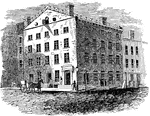Clipart tagged: ‘resign’

John C. Calhoun's Grave
John C. Calhoun (March 18, 1782 - March 31, 1850) was a leading Southern politician and political philosopher…

Fraunces Tavern
In August of 1775, Americans took possession of cannons from the Battery at the tip of Manhattan and…

Washington Resigning His Commission
At Fraunces Tavern on December 4, Washington formally bade his officers farewell and on December 23,…